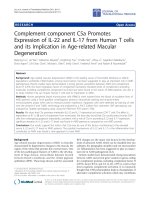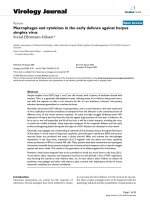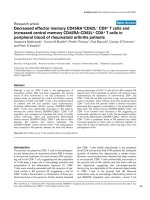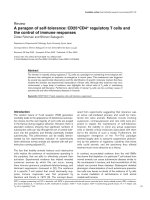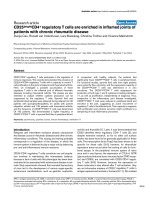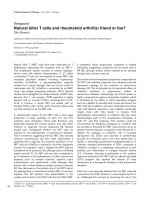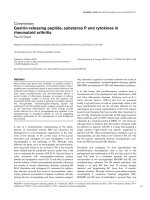Alloreactive t cells and cytokines in murine graft versus host disease 1
Bạn đang xem bản rút gọn của tài liệu. Xem và tải ngay bản đầy đủ của tài liệu tại đây (265.16 KB, 45 trang )
_____________________________________________________ Literature Survey
CHAPTER 1 LITERATURE SURVEY
1.1 Bone Marrow Transplantation
Early in the 1951, Jacobson et al. (1951) found that the lethal effects of total body
irradiation (TBI) to mice could be prevented by intraperitoneal injection of spleen
cells. In the same year, it was reported that mice and guinea pigs could be protected
from lethal doses of TBI when given syngeneic marrow intravenously (Lorenz et al.,
1951). The results of the experiment were soon confirmed in a variety of mammalian
species (Van Putten et al., 1967). The first long-term bone marrow engraftment was
reported in a 26-year-old patient with acute leukemia following one dose of TBI
(Mathe et al., 1963). Bone marrow transplantation (BMT) for the treatment of anemia
associated with leukemia of parasitic infections date back about one century ago
(Santos, 1983). Currently, it is commonly used to treat a number of diseases including
congenital disorders such as severe combined immunodeficiency (SCID), aplastic
anemia, lymphohematopoietic malignancies, solid tumours and age-related diseases
like osteoporosis and other autoimmune disease (Marmont, 1994). However, because
the donor and recipient tissues usually differ genetically, graft-vs-host disease (GVHD)
in which donor T cells react against their new host and attack host organs such as the
skin, liver, and the intestines is very common after BMT.
5
_____________________________________________________ Literature Survey
1.2 Graft-vs-host disease
1.2.1 Introduction
Graft-vs-host disease (GVHD) is a complex condition that can occur after allogeneic
BMT. Despite advances in histocompatibility matching and immunosuppressive drugs,
GVHD has continued to be a common and often lethal complication of marrow
transplantation. GVHD occurs when donor immunocompetent T cells found in the
bone marrow react against the major and minor histocompatibility antigens of
recipient. As early as 1966, Billingham defined the three pre-requisites for the
development of GVHD which includes the presence of immmunologically competent
cells in the graft, the host appearing “foreign” to the graft, and the inability of the host
to react sufficiently against the graft. The interaction of donor cells and host target
tissues in GVHD has proven to be complex, involving multiple target organs and
shifting patterns of cytokines and effector cells.
1.2.2 Classification of GVHD
GVHD can be divided into two forms - acute and chronic GVHD. Acute GVHD
(aGVHD) results in an immediate multi-organ inflammatory syndrome affecting the
skin, liver and gastrointestinal tract within the first 100 days post allogeneic BMT.
Acute GVHD can also produce a long-term immune deficiency and an increased
frequency of Chronic GVHD (cGVHD). Chronic GVHD develops usually after day
100 and describes an autoimmune-like syndrome consisting of impairment of multiple
organs or organ-systems (Sullivan, 1994). Both forms of GVHD, however, evolve
from a common starting point of donor CD4+ T cell recognition of host alloantigen and
IL-2 production.
6
_____________________________________________________ Literature Survey
Acute GVHD is a classic Th1-type response as donor T cells activated by host
alloantigens secretes mainly Th1 cytokines (IL-2 and IFN-γ) in response to host
antigens. Three elements found to be involved in the generation of aGVHD includes
donor T cell, donor (and host) macrophages and NK cells as the main effectors, and
inflammatory stimulation from environment pathogens or preparatory regimens
(Ferrara, 1993). Donor T cells responding to host alloantigens release IL-2 and, most
importantly, IFN-γ. These cytokines enhances cell-mediated response by activating
cytotoxic T ells, macrophages and NK cells. Activated macrophages and NK cells
release large quantities of inflammatory cytokines and active nitrogen intermediates,
resulting in a “cytokine storm” (Ferrara, 1993; Antin et al., 1992) that produces
systemic effects in inducing damage in target organs, mainly the gut, liver and skin.
Chronic GVHD is characterized by autoantibody production, particularly serum
IgG and IgM (Graze et al., 1994; Storek et al., 1992), and increased collagen
deposition, resulting in clinical symptoms similar to those of autoimmune disease.
Even when the same organs are affected, the pathology may be distinct in aGVHD and
cGVHD, with necrosis dominating in aGVHD and fibrosis characteristic of cGVHD.
Another differentiating characteristic between aGVHD and cGVHD is their marked
difference in the cytokine production pattern. The predominant cytokines produced in
aGVHD are Th1 cytokines while those in cGVHD are Th2 cytokines. The skewing of
cytokine profile towards Th2 cytokines is evident within the first week of cGVHD. In
the first 2 days after induction of cGVHD, a marked increase of IL-2 mRNA synthesis
and cytokine content in supernatants has been observed in cGVHD mice (Via, 1991;
Garlisi et al., 1993). Early IL-2 production is necessary for the development of Th2
cells (Ben-Sasson et al., 1990) as well as the stimulation of their activity in vivo
(Fowler et al. 1994). By day 7, IL-2 mRNA had returned to normal levels while IL-4
7
_____________________________________________________ Literature Survey
and in particular IL-10 mRNA predominated thereafter (Garlisi et al., 1993), even up
to 2 – 3 weeks (Allen et al., 1993). These Th2 cytokines are central to both the
pathology and the immune dysfunction of cGVHD.
1.2.3 Target organs and histopathological manifestation of GVHD
Murphy found that lymphoid tissue transplanted into the chick embryo causes
splenomegaly and "pocks" on the chorioallantoic membrane in 1916. Some 40 years
later, Simonsen rediscovered the phenomenon in the chick embryo just as Billingham
and Brent were discovering an analogous phenomenon in the mouse; it was given the
generic name graft-versus-host disease (GVHD), whereas in the mouse it was known
for a time as the "runt disease" (Silverstein, 2001). The classic manifestations of
GVHD are found in three organs: skin, liver, and gastrointestinal tract (Chao and
Schlegel, 1995; Hakim et al., 1998).
The first clinical manifestation of GVHD is a skin rash usually occurring at or
near the time of white blood cell engraftment. In the early states this rash maybe
pruritic, involving the nape of the neck, the ears and shoulders as well as the palms of
the hands and sole of the feet. From these initial areas of presentation, the rash may
spread to the whole integument and become confluent. In severe GVHD, the
maculopapular rash forms bullous lesions with epidermal necrolysis. Chronic GVHD
skin lesions are different and characterized by dermal fibrosis and immunoglobulin
deposits.
The second organ most commonly involved by aGVHD is the liver. The
earliest and most common abnormality is a rise in conjugated bilirubin and alkaline
phosphatase. This reflects the pathology associated with liver GVHD, that is, damage
to the bile canaliculi leading to cholestasis. Primary histological findings are bile duct
8
_____________________________________________________ Literature Survey
atypia and degeneration leading occasionally to severe cholestasis. Other histological
observations include lymphocytic infiltrates in the peribiliary areas, intraepithelial
infiltrates in the bile ducts and ductules, and degeneration of hepatocytes and biliary
epithelial cells.
The third main organ system affected by GVHD is the gastrointestinal tract,
which is often characterized by diarrhea and abdominal cramps. Diarrhea can be so
voluminous that it becomes difficult to maintain an adequate fluid balance in some
patients. In severe gut GVHD, the whole intestine may be denuded, with total loss of
epithelium. Lesions may also consist of shortening of crypts and degeneration of crypt
epithelial cells, infiltration of lymphocytes in the lamina propria, and erosion of
mucosal epithelia.
1.2.4 Effector cells involved in GVHD
1.2.4.1 T Cells
The T lymphocyte is undoubtedly the prime mediator of specific responses in GVHD.
Donor T cells rapidly expand in number in early aGVHD. In patients who went on to
develop GVHD, increased numbers of anti-host T cells were seen in the first 30 days
post-BMT. After several months, 75% of the CD4 and 50% of the CD8 T cell
population was derived from the donor (Hakim et al., 1994). This expanding T cell
population was found to be composed primarily of those cells specifically reactive to
host antigens. Depletion studies further determined that different T-cell subsets might
be involved. In donor/host strain combinations matched at class I MHC and
mismatched at class II MHC antigens, CD4+ T cells are the dominant effectors
(Korngold et al., 1987; Sprent, 1994); in contrast, in those mismatched only at class I
MHC antigens, CD8+ T cells are necessary and sufficient and CD4+ depletion has little
9
_____________________________________________________ Literature Survey
effect on mortality (Sprent et al., 1990; Serody et al., 1999). CD8+ cells are similarly
required for the development of GVHD in several MHC-matched, minor antigenmismatched strain combinations (Korngold et al., 1987).
1.2.4.2 NK Cells
Non-T cells also play a major role in both the tissue damage of GVHD and in the
cascade of inflammatory cytokines that produce systemic effects. NK cell is one of the
key players. NK cells (CD56+) are actually noted to decrease in the peripheral blood of
patients destined to develop GVHD (Soiffer et al., 1993). The use of NK-deficient
mutant mice as donor did not induce histopathological lesions in the recipient mice
(Ghayur et al., 1987).
1.2.4.3 Macrophages
Donor and host macrophages increase in number during the first weeks of GVHD.
Macrophages are ubiquitous in GVHD-affected tissues. They play a dual role in
GVHD. Macrophages serve as antigen presenting cells to activate T-cell response.
Besides, activated macrophages can differentiate into a pro-inflammatory state. When
triggered by LPS, these macrophages then secrete high titers of TNF-α, IL-1, IL-6 and
nitric oxide. These factors both increase APC stimulation of T cells and mediate the
wasting and tissue damage of GVHD (Smith et al., 1991).
1.2.5 Predicting GVHD
Both the extent of histoincompatibility between donor and recipient and, up to a
certain threshold, the number of (residual) T cells in the marrow graft (even after ex
vivo T-cell depletion) have a profound impact on the incidence and severity of GVHD
10
_____________________________________________________ Literature Survey
(Anasetti et al., 1994). Predicting the risk of GVHD before performing allogeneic
BMT is certainly an attractive approach to eventually minimize its incidence and
severity by prospective donor selection and individualized immunosuppressive therapy
in patients with low risk acute leukemia (AL). However, in order for this to be
routinely applied in BMT for patients with CML and more advanced AL, an
immunotherapeutic strategy that meets the apparent paradox of preventing GVHD
while preserving a GVL response would be required.
1.2.5.1 Genotypically HLA-identical sibling BMT
Alloreactive host-specific CD8+ and CD4+ donor T cells that cause GVHD in
genotypically HLA identical sibling BMT are directed against immunodominant minor
histocompatibility peptide antigens (mH Ags) expressed by the recipient and presented
by class I and II MHC molecules (Theobald, 1995 & 1993; Wettstein, 1995; Sugita et
al., 1994). These mH Ag reactive T cells are clonally amplified during aGVHD, and
their presence in vivo precedes the clinical onset of GVHD (Dietrich et al., 1994;
Nierle et al., 1993; Soiffer et al., 1993). The general idea is that mH Ags are derived
from normal, yet polymorphic, cellular proteins (Theobald, 1995; Wettstein 1995).
Also, retroviral gene products, including those that give rise to endogenous
superantigens, may provide mH Ags (Jones et al., 1994). A significant correlation
between the occurrence of moderate to severe (grade II to IV) acute and chronic
GVHD, and the pooled mismatches for HA1, 2, 4 or 5 was observed in adult patients
and also, although less apparent, in children. HLA-A2.1 is the most frequently
expressed human class I allele among different ethnic populations, and also that HA1
represents an immunodominant mH Ag with a phenotype frequency of 69% in the
HLA-A2.1+ subpopulation (Van Els et al., 1992), this mH Ag provides a prototype
11
_____________________________________________________ Literature Survey
candidate for prospective cellular typing in order to predict GVHD among
genotypically HLA-A2.1 matched donor-patient pairs.
Recipient-specific alloreactivity of donor T cells before genotypically HLAidentical sibling BMT is virtually undetectable by both the standard mixed lymphocyte
culture (MLC) and limiting dilution analysis (LDA) of CTL precursors (Theobald,
1995; Kaminski et al., 1988 & 1989). By modifying both the responder-cell read out
and the type of antigen-presenting cells used as stimulator cell, however, primary in
vitro assays that could predict the occurrence of aGVHD in genotypically HLAidentical BMT had been developed. These assays include the inhibition of colony
forming units-granulocyte macrophage (CFUGM) based on secondary donor-host cocultures (Delmonte et al., 1982), the skin explant model (Vogelsang et al., 1985;
Sviland et al., 1990), the mixed epidermal cell-lymphocyte reaction (Bagot et al., 1986
& 1988), and the measurement of donor autoreactivity against a pool of MHC
disparate stimulator cells (Johnsen et al., 1992a, 1992b, 1992c).
LDA has been utilized as a more clinically useful predicative assay to
determine the frequency of host-specific IL-2-secreting Th precursors (IL-2 Thps) in
the peripheral blood of genotypically HLA-identical sibling marrow donors (Theobald
et al., 1993& 1992; Schwarer et al., 1993). High frequencies of host-specific IL-2
Thps (about >1 per 100,000) have been detected before BMT in donors whose siblings
later had moderate to severe aGVHD. Among the donors for patients with mild (grade
I) or no acute GVHD, low frequencies of IL-2 Thps (about <1 per 100,000) have been
found. Naive CD8+ and CD4+ donor T cells that recognize mH Ag presented by class I
and class II MHC molecules, respectively, are amongst the responding host-reactive
IL-2 Thps (Theobald et al., 1993). Subsequent studies revealed that host specific IL-2
Th cells are involved, as critical key effector cells, in the initiation of both acute and
12
_____________________________________________________ Literature Survey
primary as well as secondary chronic GVHD (Bunjes et al., 1995b; Nierle et al.,
1993). LDA technique by Schwarer et al. (1993) could show that very low (about 1 per
300,000 to 1 per 900,000) or undetectable frequencies of host reactive IL-2 Thps in the
peripheral blood of donors before genotypically HLA-identical BMT were associated
with leukemic relapse and absence of aGVHD, whereas low to intermediate
frequencies (about 1 per 200,000) were closely related with both leukemia-free
survival and a lack of aGVHD. The relevance of cytokine-secreting donor Th cells in
the control of recurrent leukemia has also been supported by the finding that successful
therapy involving donor leukocyte transfusions in patients suffering from relapsed
CML after allogeneic BMT is indeed associated with high frequencies of host-reactive
IL-2 Thps (Bunjes et al., 1995a). These studies clearly indicate that high frequencies of
host-specific IL-2 Thps in the peripheral blood of donors before BMT closely correlate
with the development of moderate to severe aGVHD in the recipients after BMT.
Various in vitro assays based on certain modifications of the MLC have been
recently designed in order to further simplify the technology utilized for predicting
GVHD in genotypically HLA-identical BMT. To amplify otherwise undetectable
proliferative T-cell responses between HLA-identical siblings in the MLC, both the
addition of exogenous T cell growth promoting cytokines (IL-2 and IL-4), and also the
treatment of stimulator cells with cytokines such as IFN-γ and tumor necrosis factor
(TNF)-α, that are known to enhance the expression of class I and II MHC-peptide
complexes, and costimulatory ligands and adhesion molecules, has been studied
(Bishara et al., 1994). The detection of recipient-specific alloreactivity in these
modified mixed lymphocyte cultures (MLCs) was significantly correlated with the
occurrence of subsequent aGVHD. The measurement of both IFN-γ and TNF-α, rather
13
_____________________________________________________ Literature Survey
than proliferation, in the supernatants of MLCs between 34 genotypically HLAidentical sibling donor-patient pairs before marrow grafting has also been shown to be
of value in predicting grade II to IV acute GVHD (Dickinson et al., 1994).
1.2.5.2 Phenotypcally HLA-matched unrelated BMT
Marrow grafts from phenotypically HLA matched, or partially HLA mismatched,
unrelated donors represent an alternative source of stem cells for patients who lack a
genotypically HLA-identical sibling donor. The risk of developing severe aGVHD,
however, is significantly higher after unrelated, as opposed to genotypically HLAidentical sibling BMT, even when donors and recipients are well matched by methods
routinely used for donor selection, such as MLC, serology, and cellular Dw typing
(Anasetti et al., 1994). Molecular typing techniques of class I MHC genes (one
dimensional isoelectric focusing, sequence-based typing) and class II MHC genes
(restriction fragment length polymorphism, PCR amplification followed by
hybridization to sequence specific oligonucleotide probes, sequence-based typing)
have revealed that the polymorphism at each HLA locus including HLA-DPA1 and
DPB1 is by far more complex than that defined by serology (Anasetti et al., 1994).
Although allogeneic differences between class I and II that involve residues
that interact directly with the T cell receptor (TCR) can be immunogenic (Grandea et
al., 1992), most allelic variation involves MHC residues that interact with the peptide
rather than the TCR (Bjorkman et al., 1987). A single amino acid difference between
HLA-B4402 and HLA-B4403, located at the peptide-binding site of the β2 domain has
been shown to be sufficient for the initiation of a GVHD-associated and host-directed
HLA-B4402 specific alloresponse by CTLs derived from an unrelated donor who
possessed the HLA-B4403 variant (Keever et al., 1994). A difference involving a
14
_____________________________________________________ Literature Survey
HLA-DRB1 allele did not, however, induce a GVHD response by host-reactive donor
T lymphocytes (Keever et al., 1994). Also certain other molecularly defined HLA
disparities, even if they could potentially be recognized by alloreactive T cells in vitro,
such as HLA-DP mismatches, have not been formally proved to be a risk factor for
GVHD in phenotypically HLA matched unrelated BMT (Moreau and Cesbron, 1994).
It is yet to be established whether molecular typing of a single HLA allele disparity
may be helpful in predicting the outcome of marrow grafting between unrelated donorpatient pairs.
In contrast, frequency estimation of recipient specific CTLps in the peripheral
blood of donors before phenotypically HLA matched unrelated BMT has been shown,
in four out of five studies, to provide sufficient information about the prediction of
both aGVHD and survival (Kaminski et al., 1988 & 1989; Roosnek et al., 1993; Fussel
et al., 1994; Schwarer et al., 1994). High (about >1 per 100,000) as opposed to low
(about <1 per 100,000) CTLp frequencies were associated with an increased incidence
of grade II to IV aGVHD and transplant-related mortality (Roosnek et al., 1993;
Schwarer et al., 1994). Essentially similar predicative information and also a
relationship between the number of responding precursors and the extent of molecular
class I and II mismatches has been obtained by measuring the frequency of hostreactive IL-2 Thps (Schwarer et al., 1994). Considering that frequency analysis of
recipient-specific IL-2 Thps has the advantages of being more rapid, less labor
intensive, and more sensitive to class II and mH Ag disparities (Theobald et al., 1993
& 1992; Schwarer et al., 1994 & 1993), this assay provides an alternative
histocompatibility typing test for donor selection and prediction of aGVHD as well as
survival in phenotypically HLA matched unrelated BMT.
15
_____________________________________________________ Literature Survey
1.2.5.3 New approaches to testing the cellular response to predict transplantation
outcome
i)
Enzyme-linked immunosorbent spot assay (ELISPOT). The ELISPOT
has the great advantage of detecting secreted cytokines at the site of the
secreting cell. This technique utilizes wells containing membranes coated
with a primary antibody for the secreted cytokine of interest. The immune
cells are plated in the well along with the antigen. The cytokines produced
are captured at the source before they can be degraded or bound to
receptors. The cytokines can then be detected by a secondary enzymelinked antibody and counted using an automated computer-assisted image
analyzer. As it is 100–400-fold more sensitive than the detection of
cytokine in the supernatants by enzyme-linked immunosorbent assay, the
ELISPOT can detect antigen-specific cells at the single cell level. Heeger
and colleagues (1999) have shown that the presence of a high frequency of
donor-reactive memory T cells producing IFN-γ detected by the ELISPOT
correlates with an increasing risk of acute rejection early post-transplant.
ii)
Flow cytometry-based intracellular cytokine and cytokine secretion
detection. Multi-parametric flow cytometry can be used to study cytokine
production at the single-cell level and can simultaneously detect two
cyokines produced in the same cell. Secretion inhibitors are added to the
cultures following T cell stimulation to allow for accumulation of cytokines
within the cell. These intracellular cytokines can be detected upon
permeating the membrane using fluorescence-labeled antibodies specific
for the intracellular form of the cytokine. Most reported studies use PBMCs
as the responding cells (Reinsmoen et al., 2002);
16
_____________________________________________________ Literature Survey
iii)
CFSE-based cell division and precursor frequency analysis. The
conventional MLC does not allow for a quantitative assessment of the
various cell populations that respond in an antigen-specific manner. The
ability to determine the division history of specific cell populations
proliferating in an immune response is useful in quantifying the frequency
and phenotype of the various responding cells as well as identifying any
functional changes that occur during differentiation of T cells, B cells and
hematopoietic precursor cells. A recently developed flow cytometric assay
uses the intracellular fluorescent label carboxyfluorescein diacetate
succinimidyl ester (CFSE) to tag proliferating cells (Altman et al., 1996).
CFSE is non-fluorescent until it has permeated the cells, where cellular
esterases then cleave carboxyl groups from the molecule, rendering it nonpermeant and fluorescent. The succinimidyl moiety of CFSE covalently
attaches to cytoplasmic amine groups such that the CFSE is divided equally
between the daughter cells. Peripheral blood mononuclear responder cells
can be stained with CFSE, cultured with the appropriate stimulator cells for
5 days, and labeled with anti-CD3 and -CD4 monoclonal Abs (or other
appropriate antibodies for identification of the population of interest). The
intensity of CFSE is reduced by half in sequential cell division (~8 cell
divisions are detectable); the number of precursors that divide can be
extrapolated and summed to determine the number of cells that responded
to the antigen. This method has been used in the murine system (Wells et
al., 2000) to quantify T cell effector function. Reinsmoen (2001) had
reported the use of the CFSE method for identifying donor antigen-specific
hyporeactivity in solid organ recipients and found that recipients who
17
_____________________________________________________ Literature Survey
remained responsive to donor antigen by MLC, had CD3+CD4+ responder
frequencies that remained the same or increased post-transplant, while
those that developed donor antigen-specific hyporeactivity by MLC had
concomitant post-transplant CD3+CD4+ responder frequencies that were
generally <10%.
iv)
Detection of antigen-specific T cells by tetrameric HLA-peptide
complexes. A novel method based on the generation of fluorescencelabeled tetrameric HLA molecules loaded with defined peptide epitopes has
allowed the characterization and monitoring of specific viral and tumor
responses (Ogg et al., 1998). Both peptide/MHC class I and II tetramers
have been developed; however, the preparation of these complexes is
difficult and is limited to a few laboratories only. The class I/peptide
tetramers are generated by first isolating and cloning the extracellular
portion of HLA class I heavy chain and β2-microglobulin in an expression
vector and purifying these proteins in a denatured form. The refolding of
the HLA, β2 microglobulin, and peptide forms monomers and upon
purification, biotin is introduced. The tetramerization is achieved by adding
avidin conjugated with a fluorochrome. The class II/peptide tetramers are
formulated in a similar fashion but require different refolding protocols.
These MHC/peptide tetramers have very high affinity for the TCR of
antigen specific cells and can detect T cells in a frequency ranging from
10-4 to 10-5. These complexes have provided important insights into the
analysis of antigen–specific responses such as tumor specific immune
responses (Dunbar et al., 2000) and HIV-specific T cell responses (Altman
et al., 1996), and will undoubtedly augment the development of novel
18
_____________________________________________________ Literature Survey
vaccine strategies for the treatment of cancer and infections diseases such
as AIDS.
v)
ATP-based assay for T cell activation. An alternative approach for
determining proliferation involves the measurement of the nucleotide ATP
(Sottong et al., 2000). The increase in intracellular ATP has been shown to
correlate with proliferation. A luminescence-based assay is used to analyze
the ATP synthesis of specific T cell subset responses through the use of
paramagnetic particles coated with monoclonal antibodies against the
appropriate CD antigen. The ATP is measured by addition of firefly
luciferase and luciferin in the presence of magnesium ions. The ATP
produced allows the luciferase to produce light, which is calibrated to
provide a direct measure of the strength of the cellular immune response.
This assay has the potential for evaluation of the impact of various
immunosuppression protocols by assessing the affect on a mitogen
response.
1.2.6 Selective T cell depletion in the prevention of GVHD
Allogeneic bone marrow transplantation (BMT) has long been recognized as a curative
treatment for a variety of hematopoietic malignancy diseases (Armitage, 1990).
Unfortunately, GVHD remains a major source of morbidity and mortality. Although
GVHD can be prevented by removal of T cells, there is a significant increase in
relapses in recipients of T-cell–depleted grafts, demonstrating the importance of donor
mature T-cell–provided graft-versus-leukemia (GVL) effect (Kernan, 1994). GVL
effect may be mediated by both host histocompatibility antigen–specific T cells, which
also mediate GVHD, and tumor antigen–specific T cells, which do not induce GVHD
19
_____________________________________________________ Literature Survey
(Truitt et al., 1995; Barrett, 1997). In principle, GVL effect can be separated from
GVHD by selectively depleting host histocompatibility antigen–specific T cells while
sparing tumor antigen–specific T cells. It has also been reported that distinct T-cell
populations distinguish leukaemia cells from normal haematopoietic cells in the same
individual (Horowitz et al., 1990; Datta et al., 1994). Indeed, strong anti-leukaemic
reactions may be obtained without the development of aGVHD after both allogeneic
stem cell transplantation and donor leukocyte infusions (Barrett & Malkovska, 1996).
Based on this, several strategies have been proposed to separate the designated
immunological effects of allogeneic cell infusion, for example GVL, from its
unwanted consequence, i.e. GVHD. First efforts aimed at the depletion of T cells used
physical separation techniques such as soybean lectin agglutination, E-rosette
depletion (Reisner et al., 1981) and counterflow elutriation (Wagner et al., 1990).
More recently, monoclonal antibodies against T-cell epitopes have been used for in
vitro depletion. Champlin et al. (1990) suggested the infusion of CD8-depleted cells in
order to avoid GVHD. In contrast, other groups have infused limited numbers of CD8
cells after CD4 depletion (Herrera et al., 1999). Animal data, however, suggested that
both CD4+ and CD8+ cells are required for GVL reactivity (Truitt & Atasoylu, 1991).
Other strategies included the transplantation of CD5- or CD6-depleted bone marrow
(Antin et al., 1991; Soiffer et al., 1992). Recently, a gene therapeutic approach was
proposed by Tiberghien et al. (1994) and Bonini et al. (1997), who used genetically
modified T lymphocytes expressing a so-called suicide gene encoding Herpes simplex
virus thymidine kinase (HSV-tk). Expression of the suicide gene should allow
selective elimination of transduced alloreactive cells after GVHD development.
Alternatively, ex vivo activation of alloreactive cells and the subsequent elimination of
CD25 (IL-2 receptor) expressing cells using immunotoxins has been suggested by
20
_____________________________________________________ Literature Survey
Cavazzana-Calvo et al. (1990). All these strategies have been subjects of clinical trials
highlighting the importance of the problem.
Strategies such as the immunotoxin approach directed towards the selective
depletion of alloreactive donor cells while probably conserving immunological
potential against leukaemic cells or viral infections seem to be a promising alternative
for adoptive immunotherapy. Following on, a new technique for the depletion of
alloreactive cells after ex vivo activation has been proposed by Garderet et al. (1999)
and Koh et al. (1999). They used magnetic cell sorting (MACS)-based depletion of
alloreactive cells instead of immunotoxin-mediated killing. However, in analogy to
Cavazzana-Calvo et al. (1990), Garderet et al. (1999) depleted exclusively cells
expressing CD25 after alloactivation, whereas Koh et al. (1999) depleted only CD69expressing cells. A step further, Fehse et al. (2000) compared the effects of the
depletion of cells expressing CD25, CD69 or both activation-induced antigens on
alloreactivity. They found that depletion of alloreactive cells using a combination of
antibodies against both antigens was more efficient than with anti-CD25 or anti-CD69
alone. The depleted cells still conserved their potential against third-party cells. Their
data suggested that various T-cell subsets might be activated via different pathways
which induce the expression of different activation markers. Therefore, co-depletion of
alloreactive T cells activated via different pathways or the simultaneous use of
antibodies directed against several activation-induced markers (eg. CD25, CD69,
CD71, HLA-DR, CD95L, etc.) might be more efficient to prevent GVHD while
conserving adoptive immune effects.
More recently, Hartwig et al. (2002) reported that the alloreactive T cells
amongst the donor T cells could be eliminated through activation-induced cell death.
This was achieved by incubating the donor T cells in MLR with an agonistic
21
_____________________________________________________ Literature Survey
monoclonal Ab (mAb) to CD95. The residual donor cells recovered showed highly
reduced alloreactivity upon re-stimulation with the same stimulator cells, and failed to
induce GVHD upon transfer into the recipient mice of same MHC as the stimulator
cells. Soon after this, Chen et al. (2002) reported the use of another novel approach to
specifically eliminate alloreactive T cells – a process called photodynamic cell purging
(PDP). Instead of antibodies, they incubated the ex vivo activated donor T cells with a
photo-active rhodamine derivative called 4,5-dibromorhodamine 123 (TH9402). This
compound was selectively retained in the mitochondria of activated host-reactive cells
but not resting cells. The treated cells were subsequently exposed to visible light (514
nm) to deplete the TH9402-enriched activated host-reactive cells. Treatment with PDP
process inhibited anti-host responses but anti-tumor and anti-third-party responses
were preserved. This was also demonstrated in vivo showing that 90% of the tumorinoculated recipient mice managed to survive for more than 100 days without
detectable tumor cells and free from GVHD, although the same group of cells could
induce GVHD in the third party recipient mice. These new advances in selective T cell
depletion strategies have provided more approaches to modify the T-cell repertoire in
allogeneic transplants and might be useful to separate GVHD from GVL and provide
protective immunity in clinical allogeneic BMT.
22
_____________________________________________________ Literature Survey
1.3 Chemokines
1.3.1 Introductions
Chemokines are small, structurally related peptides that bind to specific seventransmembrane domain, G-protein-coupled α-helical receptors. The term “chemokine”
was adopted in 1992 to describe a family of closely related cytokine known to be
potent attractors for various leukocyte subsets, such as lymphocytes, neutrophils and
monocytes (Van Damme et al., 1992; Rot et al., 1992). They are approximately 8 to 10
kDa in size and share the ability to stimulate leukocyte motility, which is called
chemokinesis, and directed movement named chemotaxis. Chemokines are subdivided
into four different groups, based on their primary structure in which cysteines are
arranged, as CXC, CC, C and CX3C chemokines. Most chemokines have broad but
restricted target cell specificity (Zlotnik & Yoshie, 2000). According to the
physiological features, chemokines are classified as inflammatory chemokines and
homeostatic chemokines. Inflammatory chemokines are expressed in inflamed tissues
by cells on stimulation by pro-inflammatory cytokines or during contact with
pathogenic antigens. However, homeostatic chemokines are produced in discrete
microenvironments within lymphoid or non-lymphoid tissues. These constitutively
produced chemokines are involved in maintaining physiological traffic and positioning
of cells (Moser & Loetscher, 2001).
Among the chemokines, interleukin-8 (IL-8), a member of the CXC subfamily,
is the best characterized. Studies with gene knockout mice have provided evidence for
chemokines activity in vivo. In IL-8 receptor deficient mice, the immigration of
neutrophils to inflamed sites was dramatically reduced, and in macrophage
23
_____________________________________________________ Literature Survey
inflammatory protein-1α (MIP-1α) deficient mice the clearance of virus-infected cells
was hampered (Cacalano et al., 1994; Cook et al., 1995). It has been suggested that
chemokines are involved in signaling that leads to the tight adhesion of leukocytes to
endothelium (Bargatze & Butcher, 1993). Several studies showed that chemokines
could increase the affinity of integrins (Lloyd et al., 1996). The current theory of how
chemokines might change the affinity of integrins for their ligands is that they are
immobilized on the surface of endothelial cells by their carboxy-terminal end binding
to endothelial proteoglycans. This setting maintains receptor-binding activity and
avoids the immediate elimination of the chemokines by flowing blood. The other end
of the chemokines binds to the seven transmembrane domain receptors of the
lymphocyte and provides the signal mediated by G-proteins that leads to integrin
activation. Peripheral lymphocytes usually express very few chemokine receptors. This
supports that there are types of interaction of chemokines and receptors that quickly
activate lymphocytic integrins through G-proteins (Dunon et al., 1996).
1.3.2 Chemokines that attract naïve T cells
Naive T lymphocytes leave primary lymphoid tissues and migrate to secondary
lymphoid tissues such as peripheral lymph nodes (LN), spleen, and Peyer’s patches
(Picker et al., 1992). These are specialized tissues for collecting antigens and
presentation of antigens to lymphocytes. Naive CD4+ T cells express a characteristic
set of adhesion molecules: a high level of L-selectin, and low levels of α4β1, α4β7,
LFA-1, and CD44. This enables them to migrate to LNs and Peyers patches via high
endothelial venules (HEV) which express peripheral node addressin (PNAd), mucosal
vascular addressin cell adhesion molecule (Mad-CAM)-1, and intercellular adhesion
molecule (ICAM)-1 (Bradley et al., 1996). Spleen has no HEV but has a functionally
24
_____________________________________________________ Literature Survey
similar endothelial cell layer lining sinuses of the white pulp. Transendothelial
migration of lymphocytes or leukocytes occurs in multi-step processes: selectinmediated attachment and rolling, activation by chemoattractants/chemokines, firm
adhesion through activated integrins, and transendothelial migration (Springer, 1995 &
1996; Butcher et al., 1996).
A group of chemokines was examined for their function in inducing adhesion
of lymphocytes to ICAM-1 in a static condition, or arrest (firm adhesion) of rolling
lymphocytes on PNAd (a ligand of L-selectin) to ICAM-1-coated capillaries in a flow
condition that mimics the hydrodynamics of blood vessels (Campbell et al., 1998).
SDF-1, SLC, and CKβ-11 have been shown to arrest the rolling of most lymphocytes
in a flow condition, whereas LARC induced arrest of only memory type, but not naïve
CD4+, T cells (Campbell et al., 1998). On the other hand, MIP-1α, RANTES, Eotaxin,
DC-CK-1, lymphotactin, fractalkine, TARC, I-309, IL-8, and MCP-1 failed to induce
cell adhesion in the same setting. SLC also stimulated lymphocytes to adhere to
MAdCAM-1 under an in vitro flow condition, which is mediated through activation of
α4β7 (Pachynski et al., 1998). Thus, SDF-1, SLC, and CKβ-11 have the potential to
induce transendothelial migration of diverse types of lymphocytes to lymph nodes or
Peyer’s patches.
Once migrated into the lymphoid tissues, naive T cells migrate to T cell-rich
zones. Chemokines produced from dendritic cells, T cells, or accessory cells in the T
cell-rich zones may play important roles in guiding the trafficking of naïve T
lymphocytes and colocalizing them with antigen-presenting cells (APC) for initiation
of T cell activation. SDF-1 is expressed in most tissues including primary and
secondary lymphoid tissues (Tashiro et al., 1993; Bleul et al., 1998). Murine SLC
25
_____________________________________________________ Literature Survey
mRNA is detected in the T cell areas of spleen, lymph nodes, and Peyer’s patches, and
in the lymphatic endothelium, but not in germinal centers and sinuses (Gunn et al.,
1998). CKβ-11, like SLC, is detected in T cell areas of spleen, lymph nodes, and
Peyer’s patches (Ngo et al., 1998). DC-CK1, a CC chemokine, is expressed in both
germinal centers and T cell-rich areas of tonsils (Adema et al., 1997). DC-CK1
specifically attracts naive CD45RA+ T cells, but not memory CD45RO+ T cells. Again,
dendritic cells express DC-CK1 (Adema et al., 1997). Taken together, the
microenvironmental expression patterns and chemotactic activity of these chemokines
suggest that SDF-1, SLC, DC-CK1, and CKβ-11 guide T cell migration from
peripheral blood to the secondary lymphoid tissues and the T cell zones.
1.3.3 Chemokines that attract effector and memory T cells
After activation in the secondary lymphoid tissues by antigens, effector T lymphocytes
emigrate, circulate through the blood system, and migrate to sites of inflammation
(Picker et al., 1992; Mackay, 1993). The effector T lymphocytes specific for a
particular antigen migrate to tissues harboring the same antigen, resulting in a localized
inflammatory response. As the immune response wanes, memory T cells develop.
Memory T lymphocytes also have a different migratory behavior from naive T
lymphocytes, and circulate to tertiary lymphoid tissues including skin, intestines, and
other non-lymphoid tissues (Mackay, 1993). However, they mainly recirculate to
particular tissues where the antigens that activated them originated. Effector T cells
express high levels of lymphocyte function antigen (LFA)-1 and CD44, and either
α4β1, α4β7, or cutaneous lymphocyte-associated antigen (CLA) (Bradley et al., 1996).
Mucosal-homing effector T cells express α4β7, but not α4β1 (Picker 1994). On the
26
_____________________________________________________ Literature Survey
contrary, non-mucosal effector T cells express α4β1, but not α4β7. CLA+ effector T
cells specifically home to the skin (Berg et al., 1991). Memory T cells show a similar
pattern of adhesion molecule expression, but at lower levels than that of effector T
cells (Bradley et al., 1996). Regulation of expression of adhesion molecules or
interaction between cell surface adhesion molecules and their ligands on endothelial
cells or in the extracellular matrix is important for homing of effector and memory
lymphocytes (Dailey, 1998). Chemokines play important roles in recruitment of
activated or memory lymphocytes to sites of inflammation or tertiary lymphoid tissues
by controlling the activity of integrins and inducing chemotaxis.
On activation, lymphocytes up-regulate a number of chemokine receptors on
their cell surface, which increases the chemotactic sensitivity of lymphocytes to
chemokines. Activated T cells express CXCR3 (Loetscher et al., 1996a; Sallusto et al.,
1998), CXCR4 (Bleul et al., 1997), CCR1 (Loetscher et al., 1996b), CCR2 (Loetscher
et al., 1996b; Bonecchi et al., 1998), CCR3 (Sallusto et al., 1998; Sallusto et al.,
1997), CCR4 (Bleul et al., 1997; Sallusto et al., 1997), CCR5 (Sallusto et al., 1998;
Bonecchi et al., 1998; Loetscher et al., 1998), CCR6 (Baba et al., 1997), CCR7
(Burgstahler et al., 1995; Hasegawa et al., 1994), and CCR8 (Roos et al., 1997;
Samson et al., 1996; Napolitano et al., 1996). Activated T cells can be polarized to
either T helper (Th) 1 or Th2 type cells, which demonstrate differential profiles of
cytokine expression and helper functions in immune reaction. Th1 cells commonly
express IL-2, IFN-γ, and lymphotoxin, and are involved in cell-mediated immune
responses: cytotoxic and inflammatory responses, delayed-type response, and
suppression of B cell function (Mosmann et al., 1996). Th2 cells express IL-4, -5, -6, 9, and -10, and encourage antibody production (especially IgE), eosinophil function,
and allergic responses (Mosmann et al., 1996). CD8+ T cytotoxic (Tc) cells can be
27
_____________________________________________________ Literature Survey
polarized into Tc1 and Tc2 cells in a manner similar to that of Th1 and Th2 cells
(Mosmann et al., 1996). Before polarization into Th1 and Th2 cells, naïve cells go
through an intermediary stage: Th0 cells expressing IL-2, IL-4, and IFN-γ (Paul et al.,
1994). Th1 and Th2 cells also differ in expression of adhesion molecules. Th1, but not
Th2, cells express P-selectin glycoprotein ligand-1 (PSGL-1), a functional ligand for
E- and P-selectin (Austrup et al., 1997; Borges et al., 1997). Chemokine receptors
CCR5 and CXCR3 are preferentially expressed in Th1 cells over Th2 cells, whereas
more CCR3, CCR4, and CCR8 are expressed in Th2 cells than Th1 cells (Sallusto et
al., 1998; Bonecchi et al., 1998; Sallusto et al., 1997; Loetscher et al., 1998; Zongoni
et al., 1998; Qin et al., 1998). Chemotactic responsiveness of Th1 and Th2 cells to
chemokines is different from each other and correlates with the chemokine receptor
expression profiles in the two types of effector T cells. MIP-1β and IP-10 better
attracted Th1 cells than Th2 cells, whereas MDC, TARC, I-309, and eotaxin
demonstrated higher chemotactic activity for Th2 than for Th1 cells (Bonecchi et al.,
1998; Zongoni et al., 1988; Siveke et al., 1998). Activation by IL-2 is important in
maintaining cell surface expression levels of some chemokine receptors such as CCR1,
CCR2, and CCR5 (Sallusto et al., 1998; Loetscher et al., 1996b; Loetscher et al.,
1998). Some cytokines have regulatory activity on expression of several chemokine
receptors. Transforming growth factor β (TGF-β) enhances expression of CCR4 and
CCR7, and decreases expression of CCR3. IFN-α up-regulates the expression of
CCR1 and CXCR3, and down-regulates CCR3 (Sallusto et al., 1998). Thus these
cytokines regulate not only T cell polarization, but also change the migratory behavior
of effector T cells by modulating expression of chemokine receptors.
28
_____________________________________________________ Literature Survey
1.3.4 The roles of chemokines in transplantation and GVHD
Because the chemokine system plays an essential role in host defense, it is not
suprising that chemokines and their receptors may be involved in rejection of
allogeneic transplants (Hancock et al., 2000a). In the heart and skin transplants, an
early mixed inflammatory response that is characterized by neutrophil and monocyte
infiltration is observed. Concurrently, neutrophil-active chemokines, such as MIP-2
and KC, and monocyte-active chemokines, such as MCP-1, appear. Several days after
the allogeneic transplant, while MCP-1 persists, IP-10, Mig and I-TAC, which are all
ligands for CXCR3, appear along with MIP-1β and RANTES, which are ligands for
CCR5 (Yun et al., 2000; Belperio et al., 2000; Watarai et al., 2000; Kapoor et al.,
2000; Kondo et al., 2000). This assortment of chemokines may be necessary for
orchestrating the movement of cells involved in acute rejection. Indeed, analysis of
mice carrying target deletions of these chemokines and their receptors clarifies their
importance in allograft rejection. For example, heterotropic cardiac transplants across
MHC class I and II barriers survived twice as long in CCR1-/- mice compared to wild
type mice, and low dose of cyclosporine A was enough to produce permanent
engraftment in the former (Gao et al., 2000). These analyses have been extended to
mice that are deficient in CCR2, CCR5, CXCR3 and IP-10 (Hancock et al., 2000a).
While CCR2-/- recipients of cardiac allografts had an extended survival time similar to
that of CCR1-/- recipients, CCR5-/- and CXCR3-/- recipients showed a 3× and 8×
longer graft survival time respectively in the absence of additional intervention. Again,
low doses of cyclosporine A resulted in permanent engraftment without evidence for
chronic rejection or graft arteriosclerosis (Hancock et al., 2000b).
Since GVHD involves the specific recruitment of activated lymphocytes to
target organs, chemokines may play a role in this process. The CC chemokine,
29


